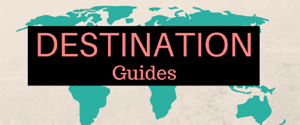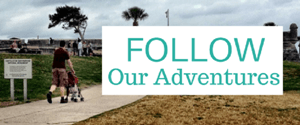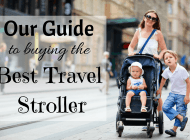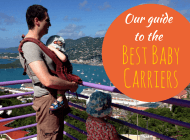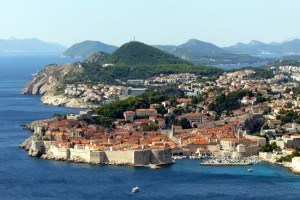I have to admit, before doing some research I didn’t know much about Oslo. Outside of the Nobel Peace Prize I wasn’t sure I could name anything else about it. What is there to do in Oslo? is a question I admit I had to ask when we decided to visit. Especially for kids. I soon found out that there is quite a lot of things to do in Oslo, Norway, including things that are great for kids.
Our stay in Oslo was going to be short. Only two nights which was then slashed when our flight was cancelled and we arrived about 16 hours later than planned! Thankfully I had a “things to see in Oslo in one day” list for our visit.

Thanks to Oslo’s compact size, good transport and great attractions, it was still easy to have a great day and see quite a lot! We fitted in more than I thought we would. Oslo is a great city for exploring and I wish we had much more time than what was available. It is a city that has a lot to offer visiting families.
Read below for ideas about what to do in Oslo for kids and other Oslo attractions.
Contents
Top 10 things to do in Oslo
The Bygdoy Peninsula
We started on the Bygdoy Peninsula. Not only does it have a great range of attractions within short distances to one another but it is also a lovely place to walk around.
The Ferry to Bygdoy

Catching the ferry to Bygdoy
To get to the Bygdoy peninsula there is a small ferry that stops at two places on the island and travels in an anti-clockwise direction. It departs from wharf F, close to Rathaus tram stop, on tram route 12. There’s a ticket office off to the side and the ferry is free with the Oslo Pass.
Ferries leave roughly every 20 minutes during the day, at 5, 25, and 45 minutes past the hour. Only every second ferry is meant to handle strollers. I had no problem either time but I caught the same ferry in both directions. Carrying a folded up stroller on shouldn’t be an issue.
It’s a bit of an attraction in and of itself. S enjoyed catching the boat and there are some good views from the bow and stern.
The number 30 bus (to Bygdoy) also goes past all of the attractions listed in this section.
Viking Ship Museum

A Viking longship at the Viking Ship Museum.
About 300 metres from the ferry’s first stop on the island is the the Viking Ship Museum. This was one of the attractions in Oslo I was looking forward to the most. The stars of the show are a collection of real viking longboats, built in the ninth century and used as funeral boats, being pushed out to sea with the deceased and later sinking into the mud. They were dug up in the 1950s.
Several of the boats are in great condition and this museum cleverly lets you walk around them and also view them from above. Also in the small museum is a collection of other viking artifacts that are also in great condition for their age.
S hadn’t heard of the vikings before and wasn’t enthralled with the boats. She was impressed by the fact that people worked, slept, cooked and ate in the pretty small boats and loved looking at the artifacts and talking about life on board the boats. It’s a small museum and you don’t need long to get a good look at those famous boats. It’s easy to push a stroller around inside, too, if you need to.
Outside there is a small outdoor restaurant serving food, a large grassy patch and small playground. If you’re spending the day on the Bygdoy peninsula then this could be a great place to stop for a nice outdoor lunch and play.
500 metres south of the Viking Museum is a cluster of maritime themed museums, two of which we visited. The second ferry stop is at this cluster.
Kon-Tiki Musuem
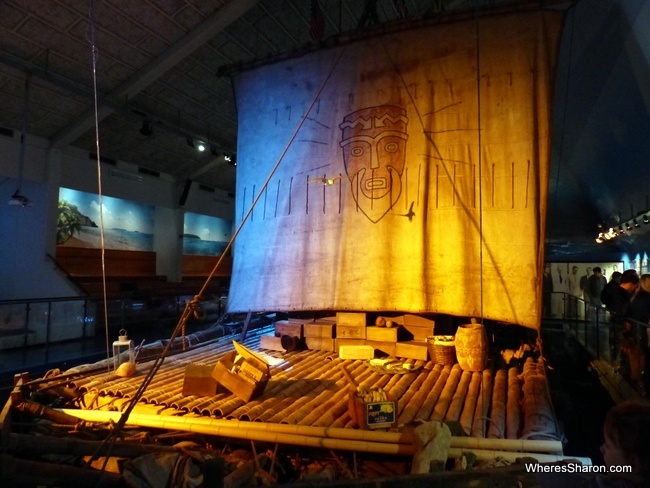
Thor Heyendahl’s balsa wood ship, the Kon-Tiki, in the musuem of the same name.
The tale of how Thor Heyerdahl and his crew sailed from Peru to Tahiti on a boat made of balsa wood is amazing. With no ship building or sea-faring experience they cut down the trees needed, built the ship and sailed it in the space of just months!
Located about 500 metres from the Viking Musuem, the Kon-Tiki Museum shows the story of how they did it and impressively has the original boat itself. It’s not a big museum but holds the Kon-Tiki, Heyerdahl’s later ship the Ra (made with reeds), and goes over much of his life’s work and research.
Although there’s no dedicated kids area the inside is really well done to keep the attention of kids. Not only is the boat itself a real visual drawcard but there’s an area under the boat made to simulate being under the ocean, and one simulating Easter Island caves and their smaller statues.
Between these, the story of the boat, and the documentary on show S wanted to spend more time here than I thought. She asked lots of questions and was really fascinated. The museum was more kid-friendly than I had originally hoped for.
Fram Museum

On the deck of the Fram, the wooden ice-breaker.
Ice and wooden ships don’t mix. Just ask Sir Earnest Shackleton or Sir John Franklin.
So during my research on Oslo tourist attractions I was surprised to find out there was once an Ice Breaker made of wood – the Fram. With a specially strengthened hull, the Fram set records for the furthest point both north and south of the equator by a wooden ship.
Housed, like the Vasa in Stockholm, in it’s own museum not only can you see the Fram but walk through it as well! You could access the top deck as well as walk around some of the lower ones. The walls of the museum were covered in information about the ship’s design and construction plus exhibits and stories from her voyages. I found walking on the ship amazing and S loved it.
Almost as good is the kids’ explorer themed activity area. There’s games and a “polar” region they can jump and slide around in. Kids and adults can test their strength to see if they could pull 150 or 300kgs of sled behind them (S staggered me by “pulling” 150kg – she’s stronger than I thought). There were several things we could do together, too.
There was a small cafe and toilets.
We could have spent a lot longer here than the hour we did. There is a lot to see, read and do. It really was both interesting and fun. In my opinion this is one of the top things to see in Oslo – especially with kids.
Other attractions on the Bygdoy Peninsula
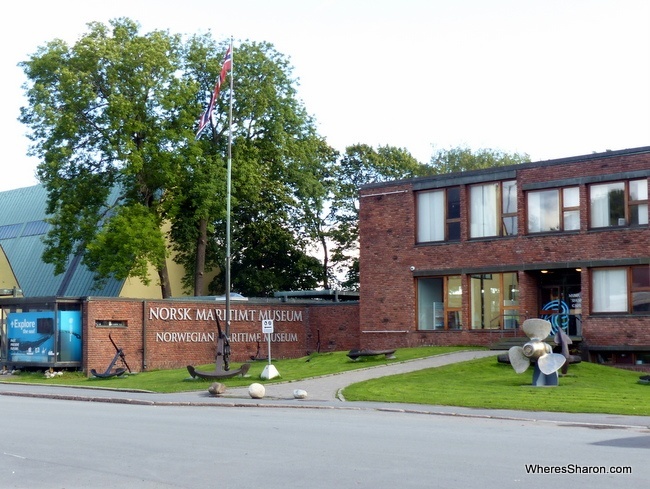
National Maritime Museum
On Bygdoy there are some other attractions that we’d liked to have visited but didn’t have the time for.
200 metres to the north of the Viking Ship Museum is the Norwegian Folk Museum. It is an open air museum with over 150 traditional Norwegian buildings. There’s a calendar of kids activities too – when we were in Oslo there were events celebrating the traditional potato harvest time for children.
At the southern tip of the island, along with the Fram and the Kon-Tiki, is the National Maritime Museum. With s bigger collection of displays than the other museums it would have been good to check it out, but we just did not have the time.
There is a lot to do in Bygdoy, easily enough for a whole day in itself. It’s a nice place to walk around too.
Sentrum
The centre of Oslo, called Sentrum, is where the rest of the Oslo attractions we visited were located. It’s a small area, and easy to get around.
Nobel Peace Center
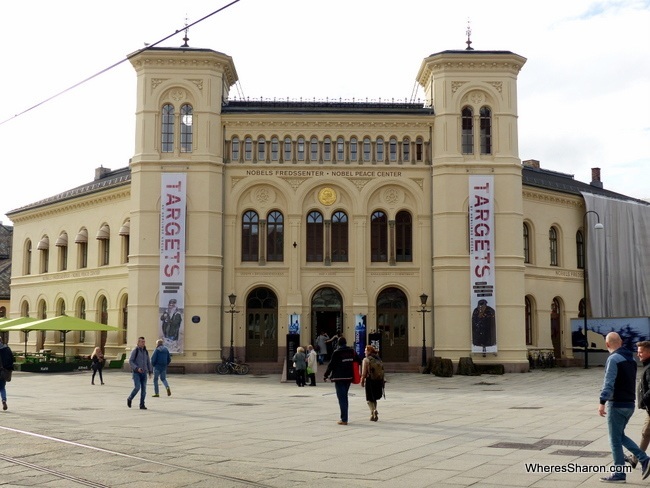
The Nobel Peace Center.
Right near the wharf where the Bygdoy ferries arrive and depart is the Nobel Peace Center. S remembered the Stockholm Nobel Museum and was excited to visit its Oslo equivalent, possibly because she hoped to receive another chocolate centred Nobel Prize of her own.
When Nobel laid out his wishes for what would become the Nobel Peace Prize, he specified that it be awarded by the Norwegian Parliament, instead of a Swedish institution like the others. No one is sure why – it’s not even clear if Nobel even visited Norway. However, as a result the Nobel Peace Prize is awarded annually in Oslo.
The Center focuses on Nobel, the Peace Prize, its winners, and the theme of peace in general. The lower floor is home to temporary exhibits. When we visited there was a display of war-zone photographs that the staff said might be disturbing to S, so we skipped it.
Upstairs there are displays focusing on particular winners telling their stories, and a coolly decorated room with touchscreen displays for each and every winner ever. An interesting fact I learned is that while each year a report on nominees is prepared, there’s no minutes of the committee meetings deciding the winner. Hence its often not known why one nominee won over the others.

S listens to Malala Yousafazi speaking about what she went through before winning her prize. The uniform she was wearing the day she was shot by the Taliban is on the left.
S really enjoyed learning about some of the winners, especially 2014 winner Malala Yousafazi, and listening to their stories where there was audio, She was full of questions and very interested.
There’s a cafe in the center, plus toilets and a place to put your strollers. If you need a small stroller the center has a couple for use.
Oslo City Hall

Oslo’s City Hall
Near the Nobel Peace Center, and one of most visible places to visit in Oslo, is the Oslo Town Hall. Although built in only 1950, it’s famous as the place where the Nobel Peace Prize recipients receive the prize and give their lecture. There’s more to see than that, however.
You can see the large hall free of charge, as well as some of the city’s art collection. The Oslo Card allows you to go on one of the guided tours (available in English) which gives you access other areas as well.
Sadly we got there too late to see inside, but we did have a look at the eclectic mix of decorations on the outside.
Royal Palace and Slottsparken
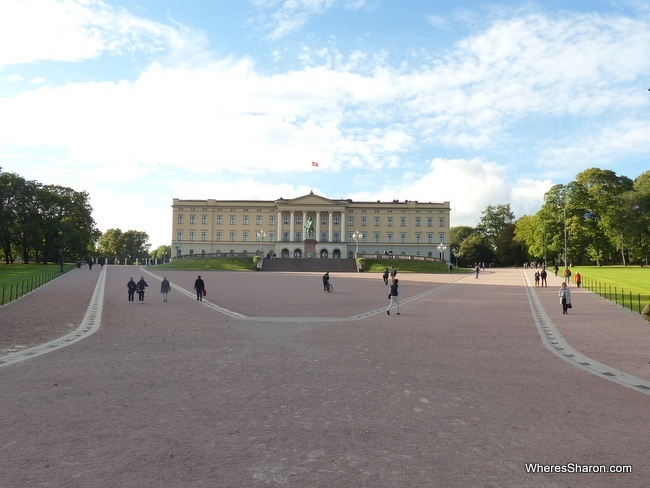
Royal Palace
Near the western edge of the Sentrum area is the Royal Palace, surrounded by the wonderful Slottsparken. it’s a large grassy park perfect for a run around in. There’s lots of trees and shade and while we didn’t see any play equipment, S enjoyed the space nonetheless.
Its one of the best places in Oslo – or its centre anyway – for young kids to be active. It also makes a great place to have a picnic.
Oslo Cathedral

The wonderful wooden sculpture in the naive of Oslo’s Cathedral.
The Oslo Cathedral is one of the places to see in Oslo closest to our hotel so we had a look. Our timing was good as we left it to last – on Fridays (when we were there) it is open from 4pm to 6am. It’s more regular hours on other days of the week.
It’s small, but the inside is richly and beautifully decorated. The ceiling is magnificent. The Cathedral is one of the free things to do in Oslo.
The Opera House
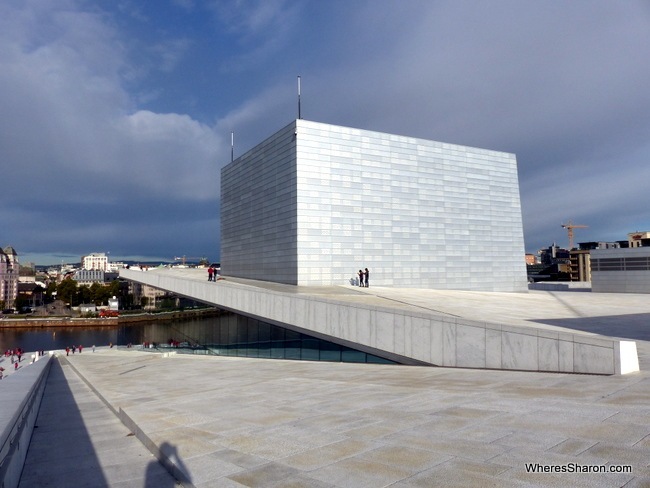
Oslo Opera House
The Oslo Opera House was also a short walk from our hotel and we had a fun morning racing around here before we left Oslo. It is a great spot to visit.
We didn’t go inside. Instead the cool architecture allowed us to walk up the side and on to the roof which the kids thought was cool (actually so did we!). It is perhaps the most interesting building we saw in Oslo – it’s quite unique.
From the roof there’s some of the best views of central Oslo.
Other things to do with kids in Oslo
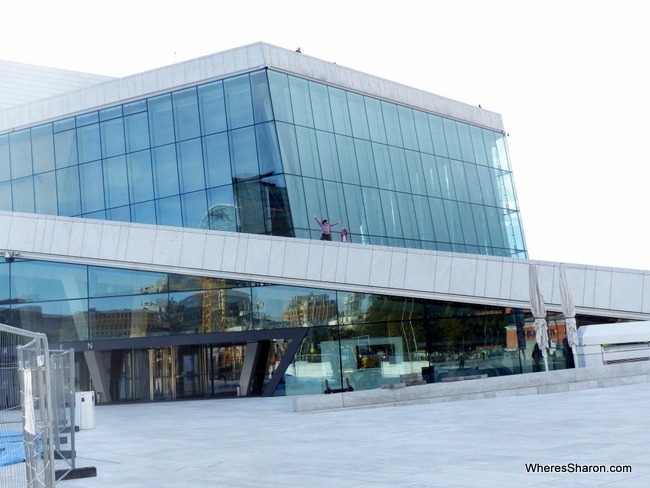
S and Sharon at Oslo Opera House
As I said earlier, for a small city there are a lot of things to see in Oslo. This is true for kids, too. We focused on the Bygdoy Peninsua and the centre of the city when deciding the attractions in Oslo we would visit. Further out, there’s some other great kid focused attractions I’d love to have seen.
The International Museum of Children’s Art would have been high on the list as our kids love to draw and create and S was very interested in this attraction when we went through the Visit Oslo site prior to our visit. A visit to Olso Summer Park or Winter Park (depending on the time of year) would be great, too.
The Visit Oslo website has a list of kid friendly attractions to check out. It’s a great resource for finding attractions in Oslo for kids.
The Oslo Pass
To make our trip to Oslo easier we had the Oslo Pass. It gives free access to a big range of attractions in and around Oslo including everything above. It also allows free access to public transport for the duration of its validity.
It’s easy to use. We used the Visit Oslo app to put the pass on Sharon’s phone. We could activate the pass through the app. To use a pass to visit an attraction the app displayed a QR code which was scanned at each place. No card to go buy or use – it was really simple. You can buy physical cards, too, if you prefer.
One thing to keep in mind if using the app is that passes cannot be passed between phones. We had three passes and we put them all on Sharon’s phone. This was a mistake as we often like to separate and do different things and then we couldn’t – keep this in mind when working out where to put the passes.
You can find out more information about the passes here.
Oslo accommodation for families

Main bedroom in our family suite
We stayed at the superbly located Clarion Hotel Royal Christina in a family suite with a separate bedroom and lounge that worked really well for the kids and us parents. The hotel is superbly located, opposite the Oslo central station. It meant it was easy to catch just about any tram, train or bus route in Oslo and we could walk to many attractions.
There’s a small but visually stunning pool and our kids enjoyed the great breakfast there, with a lot of healthy and allergy sensitive food – great for poor Z who isn’t big on dairy. There was a nice sauna, too, which helped my legs recover from all the walking around.
You can read our review of the Clarion Hotel Royal Christina for more details or click here to see the latest prices.
Getting around Oslo and Oslo public transport
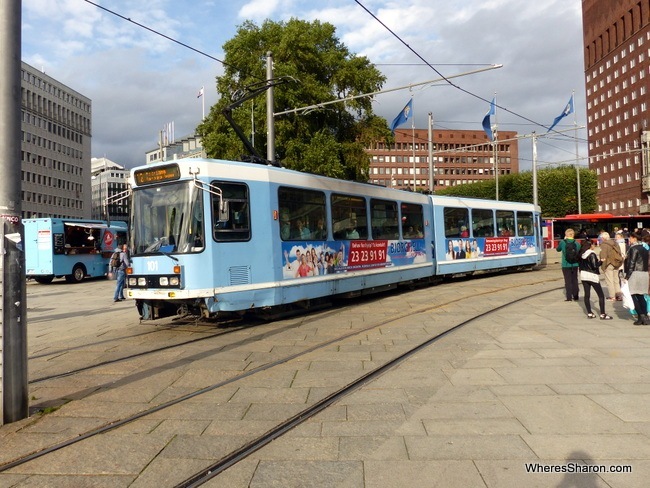
One of Oslo’s distinctive blue trams.
Getting around Oslo is easy. The centre of the city is very walkable and pram-friendly. There’s little in the way of slopes or hills (so you’ll see plenty of bikes) and footpaths are mostly wide and easy to use.
The centre is also very compact. Most of the time we got to where we were going much quicker than expected, simply because the distances are so small. It helped us cover a lot of attractions in a short time frame.
Public transport in Oslo is very good. There is a tram network (trams are mainly blue), a bus network (with red buses) and also a metro system. These cover the centre of the city very well. All metro and tram routes pass through or near Olso’s central station. Many bus routes pass by as well making the station a good place to go to catch something.
We didn’t catch any buses but the trams were frequent and busy and not too crowded. If using strollers, the second door of trams is designed to make it easier to get your stroller on and off.
Oslo airport transportation is good too. There is the express train, Flytoget, which gets from Oslo Central Station to the airport (and vice versa) with just one stop in roughly 20 minutes. It’s fast and comfortable. People under 16 are free (when accompanied by an adult) and we paid 360 Krona per adult for a return ticket.
If you have more time there are regular trains and buses that take longer but are cheaper for adults – you do need to buy kid tickets on these options though, so we found it didn’t cost much more to just get the express train.
Budget
It’s true what they say about Norway – Oslo is expensive. Even basic meals at fast food places were expensive – we typically spent more than 300 NOK for the few meals we bought and we were trying to be cheap.
Attraction prices were quite variable, with adults usually costing around 80 to 100 NOK per place which we think is good value. Luckily for families kids – especially young kids 6 and under – are usually free. The Oslo Pass was a good cost saving for us.
Oslo with kids

S trying to pull a simulated 150kg sled through the snow at the Fram Museum.
There’s a lot to like about Oslo as place to visit with a family. We mostly visited adult focused attractions but Miss 5 still had a great time and was very interested by many of the museums. Unfortunately, Mr 3 mostly missed out as he was too tired from the long journey to Oslo to do much.
There’s lots of fun things to do in Oslo that will keep a family occupied for at least a few days.
if you don’t have much time then focusing on Bygdog is a good idea. Not only is there a ferry that’s entertaining for kids but there’s some great places to visit too. It was definitely our highlight.
Admission to attractions that aren’t child-focused were free for S. I didn’t need to pay for her entry once. Many of the attractions were free for kids of all ages. It made Oslo a good value destination for a family, especially with young kids.
Our verdict
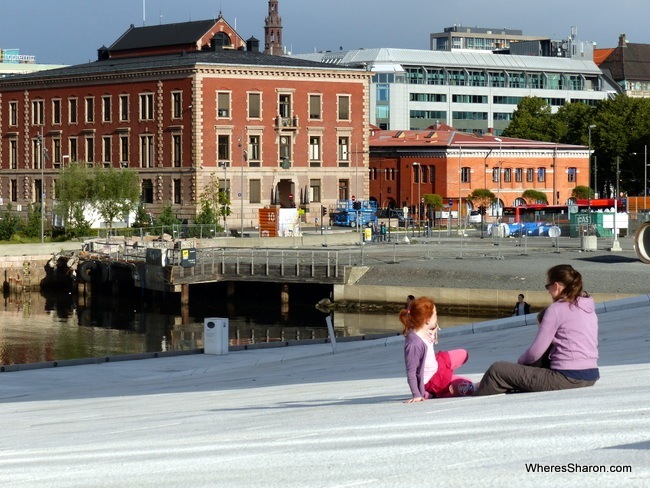
Taking in Oslo from outside the Opera House
We enjoyed our stay in Oslo and I’m disappointed that our time was so short. There’s a lot more I would have loved to have done had we been able to. Oslo has a great range of attractions, many of which are unique.
The Fram Museum was a real highlight for both S and myself.
Although it is easy and pleasant to walk around in, Oslo isn’t a city where walking around can be an attraction in itself. There’s no old town or district and the streetscapes are nice rather than stunning. In my opinion, it’s the individual attractions that make Oslo a great place to visit with kids, rather than just hanging out or wandering around.
Given the great attractions and how easy it is to get between them, Oslo is a great place to visit with kids.
Visiting more of Scandinavia? Check out our guides to Stockholm and Helsinki.
Have you been to Oslo? What tips can you share?
We partnered with Visit Oslo during our time in Oslo to ensure that we had the best family friendly experiences to share with you.
Tags: Norway Travel Blog








